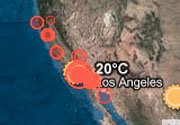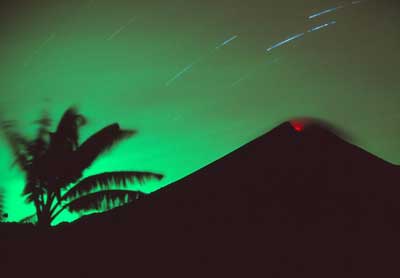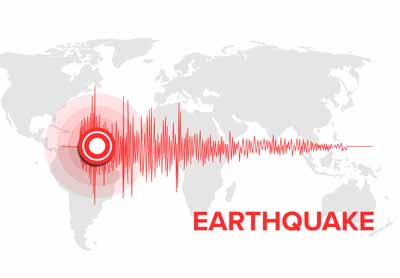Volcano calm at surface but for how long?
Update Tue 28 Jun 10:50

Etna's trmor amplitude (ESLN station, INGV Catania)
There has been no particular surface activity at the volcano since the violent summit eruptions in late May, but the volcanic tremor amplitude has been gradually rising over the past days.
This could [speculation!] indicate a phase of magma migrating to the surface, and possibly herald new activity in the near future. Etna, always good for surprises, will tell.
Volcano remains calm, image of summit craters filled with lava
Update Mon 06 Jun 14:20

Panorama over Etna's summit craters (l: Bocca Nuova, c: Voragine; r: NE crater) taken on 3 June from the southern rim of Voragine (image: B. Behncke)
Etna has remained calm at the surface since the most recent eruptive phase (violent strombolian activity from the NE and Voragine summit craters) ended on 26 May.
The attached picture, taken on 3 June by volcanologist
Boris Behncke (INGV Catania), shows significant changes of the summit region in the past weeks, in particular the near-complete filling of the Bocca Nuova and Voragine craters with lava and the partial collapses on the older NE crater.
Strombolian activity in Voragine ceases, remains restless
Update Fri 27 May 07:45
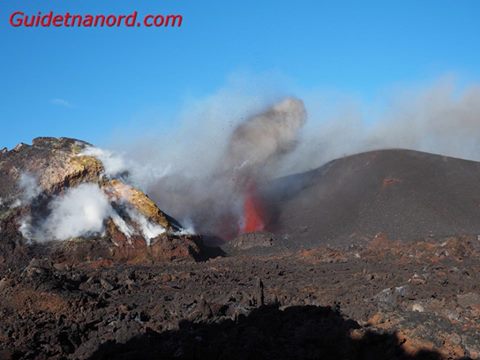
Strombolian activity from Etna's Voragine on Wednesday

Current tremor signal (ESLN station / INGV Catania)
The violent strombolian activity from the Voragine summit crater continued all though Wednesday (25 May) and the following night, but gradually decreased and ceased yesterday. At the moment, no significant eruptive activity is going on.
To see images and videos of this recent activity, you could visit the
facebook page of the mountain guides from Etna Nord.
At the moment, tremor is still elevated and seems to be increasing slowly again - maybe some new pulse of activity is in the making?
4th paroxysm of Voragine summit crater in progress
Update Tue 24 May 19:57
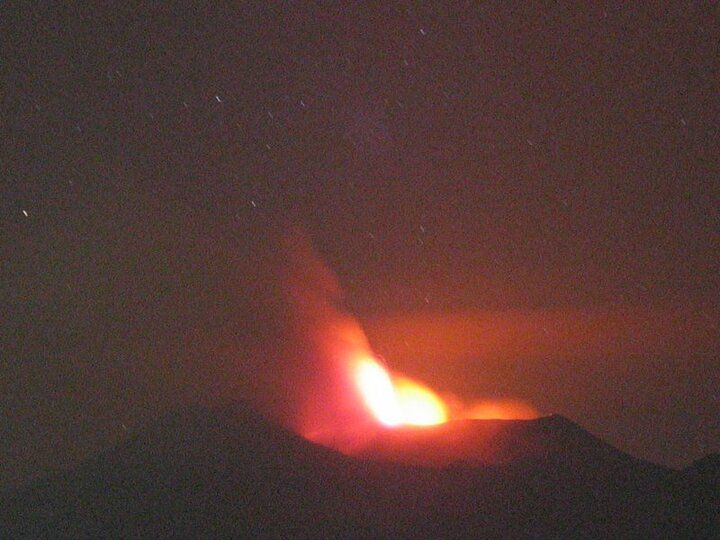
Lava fountaining from Etna's Voragine

Seismic trace of ESVO station (INGV Catania)

Current tremor signal (ESLN station / INGV Catania)

View of the lava fountain from Montagnola (INGV webcam)
The 4th episode of lava fountaining has started at the Voragine summit crater.
Tremor and the sporadic (but sometimes relatively strong) strombolian explosions at the Voragine, which had started last evening, decreased in the morning. Shortly after, it began to increase again gradually, and this increase has strongly accelerated during the past 1-2 hours: activity moved from discrete explosions to continuous fountaining (and is at the moment still increasing).
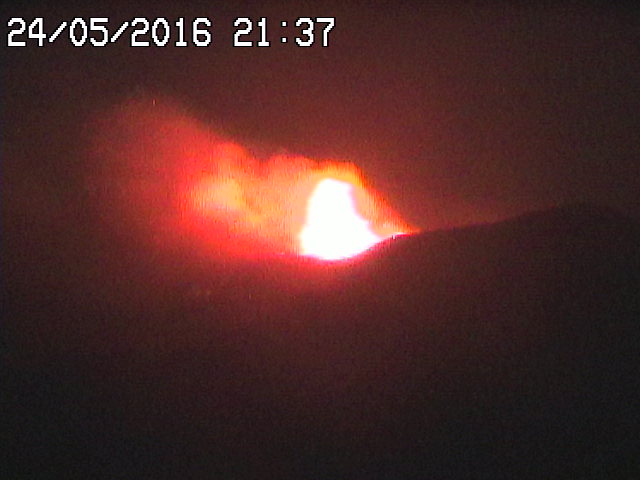
Lava fountaining from Voragine
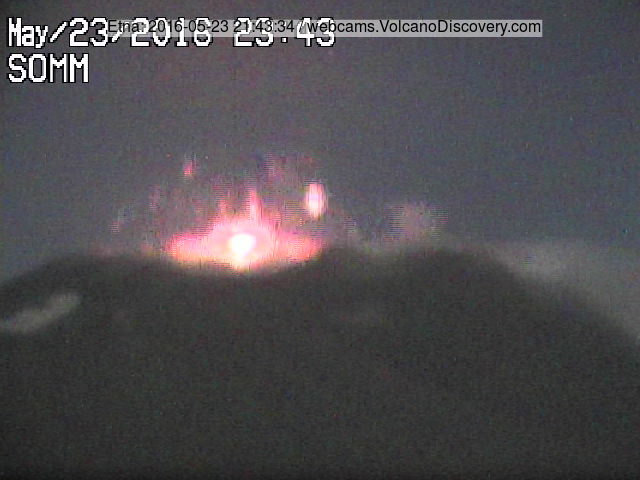
Strombolian explosion at Voragine last night
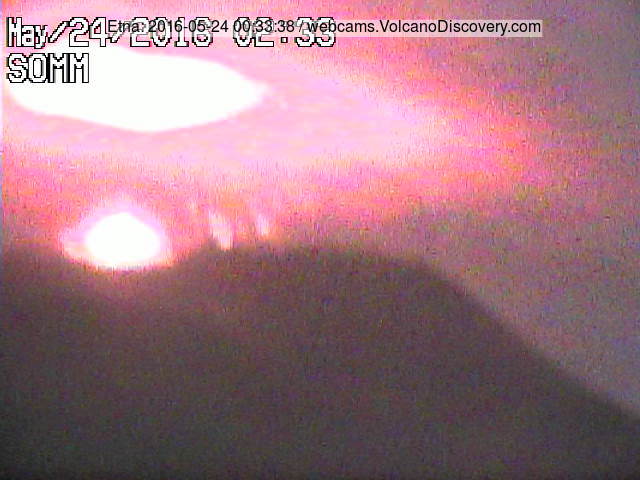
Strombolian explosion at Voragine last night
Strombolian activity from Voragine crater
Update Mon 23 May 21:31
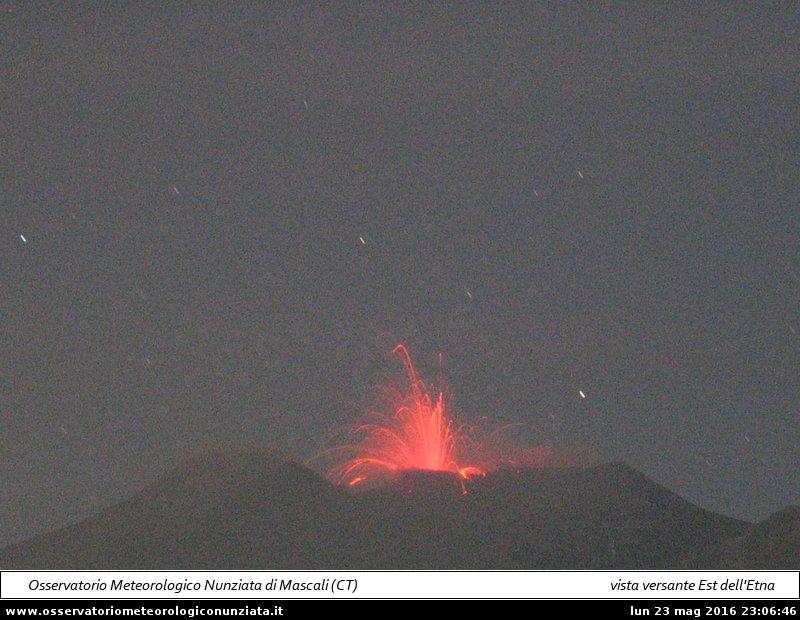
Strombolian activity at the Voragine Crater (Osservatorio Meteorologico Nunziata webcam)
Starting from 21:00 this evening weak Strombolian activity has again started from the Voragine crater together with some ash emission.
The tremor however is still low, but the webcams show that activity is increasing.
ETNA UPDATE, 23 MAY 2016, 17:30 UTC (INGV Catania):

The photo above at left, courtesy of Alessandro Lo Piccolo, shows the explosive activity at the Voragine at right, and the little lava flow further left, which had advanced a few hundred meters.
During the past few days, two further eruptive episodes have taken place in Etna's summit area:
The first, in the early morning hours of 21 May 2016, occurred at the Voragine, which had been the site of two paroxysmal episodes on 18 and 19 May. This latest episode was preceded by modest Strombolian activity, which started around noon on 20 May, producing explosion noises audible in a vast area on Etna's southern and eastern flanks.
In the night, the activity gradually intensified, with explosions from two or three vents within the Voragine. Contemporaneously, renewed inflation of the summit area was recorded by a clinometer at Punta Lucia, to the northwest of the summit craters, as had happened also before the preceding paroxysms.
Shortly after 04:00 local time (=UTC+2) and accompanied by a rapid increase of the volcanic tremor amplitude, the Strombolian explosions passed into pulsating jets of lava, launching incandescent bombs to a distance of about 1 km (to the southern base of the Bocca Nuova), and an eruption column was blown by the wind toward south-southeast.
The images recorded by the thermal monitoring camera at Monte Cagliato (EMCT, on the eastern flank of Etna) show that eruptive activity also occurred form a vent in the southern portion of the Northeast Crater, which had collapsed on 18 or 19 May.
Visibility was rather reduced due to weather clouds and further deteriorated in the final phase of the paroxysm. Yet it was possible to observe, during the climax of the paroxysm, that a fracture formed on the southeastern flank of the central cone, and in the "saddle" between this cone and the old cone of the Southeast Crater an effusive vent became active, which emitted a small lava flow toward the Valle del Leone (s. image).
Again, lava erupted from the Voragine spread out over the floor of the nearby Bocca Nuova, already completely filled by the earlier lavas from the Voragine, and overflowed its western rim, feeding a multilobate lava flow that covered the lavas from the overflows on 18 and 19 May. The activity started to diminish around 05:00 local time, and was essentially over by 06:00.
Since the morning of 22 May, the eruptive vent formed o 25 November 2015 on the upper east flank of the New Southeast Crater cone was the source of a series of ash emissions, with plumes which in the absence of wind rose several hundred meters above the summit and then dispersed in the atmosphere.
Some of these emissions produced small anomalies in the images of the thermal camera EMCT, pointing to the presence of hot material. On the evening of 22 May, Strombolian activity resumed at the Northeast Crater, which continued at fluctuating rate and intensity through the night.
The strongest explosions ejected incandescent bombs up to a few hundred meters above the crater rim, some of which fell onto the flanks of its cones. Today, 23 May, sporadic ash emissions continued from the vent on the upper east flank of the New Southeast Crater cone.
Strombolian activity from North East crater calms down
Update Mon 23 May 09:33
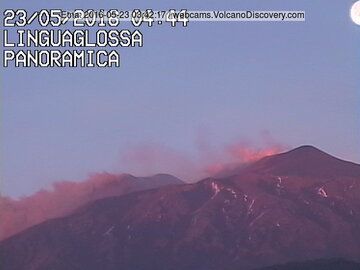
Ash emission from New SE crater this morning

Strombolian explosion at NE crater earlier in the night

Current tremor signal (ESLN station / INGV Catania)
Contrary to what it might have looked like, the volcano's activity from last night did not continue to increase, but quieted down for now.
Strombolian activity from the Northeast crater seems to have ceased during the second half of the night or early this morning. However, the volcano remains very restless: sporadic ash emissions occurred from the New SE crater and tremor remains slightly elevated, but shows no clear trend right now.
Strombolian activity from NE crater
Update Sun 22 May 22:29
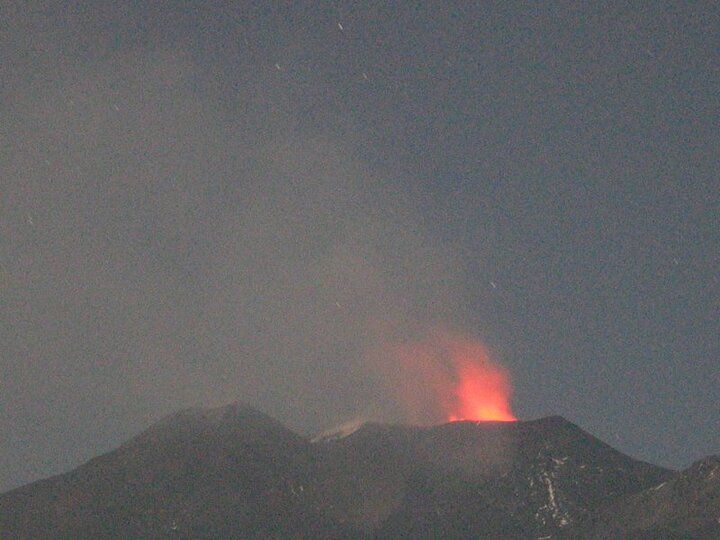
Strombolian activity at the NE crater this evening

Current tremor signal (ESLN station / INGV Catania)
Yet another paroxysm could be under way from the summit craters: after a calm day, strong strombolian eruptions have started a few hours ago from the NE crater. Along with the volcanic tremor signal which is rising again, the activity has been gradually increasing.
This might be the beginning of another paroxysm (if strombolian activity from the NE vent is a precursor of more violent activity of the Voragine or even the NE crater - the near future will tell...)
You can follow the activity live at
various webcams.
Third paroxysm at Voragine summit crater in less than 72 hours
Update Sat 21 May 08:48

Etna's paroxysm this morning (image: Turi Caggegi / youtube)

Current tremor signal (ESLN station / INGV Catania)

Etna seen from the SE (image: Boris Behncke / facebook)
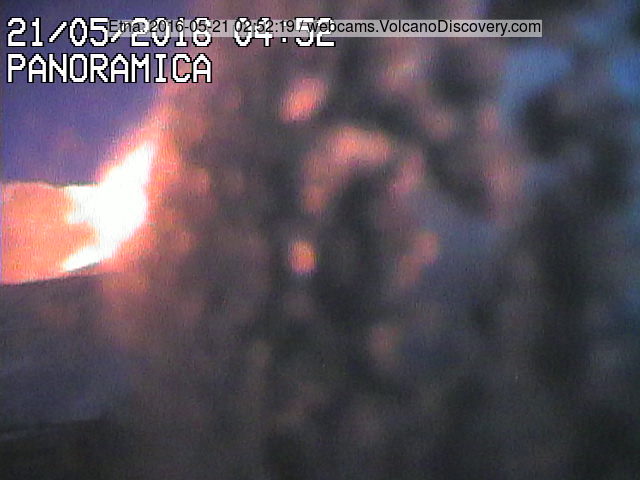
View from S during the peak of the paroxysm (RadioStudio7 webcam)
The 3rd paroxysm (violent summit eruption with lava fountains) of Etna's Voragine occurred over night and ended at dawn. It was significantly less strong than the previous ones, but produced spectacular strombolian explosions and pulsating lava fountains from the summit crater.
The gradual increase of strombolian activity that had set in in the evening culminated in a short phase of lava fountaining which peaked between 4 and 5 am. Only a small ash plume was generated during the eruption. It drifted east and southeast from the volcano, causing light ash fall in villages and towns such as Pedara, Viagrande, Giarre.
Bad weather prevented detailed observations, but it seems that also a lava flow was effused from the summit vent and traveled onto the upper western flank (s. image taken by
Boris Behncke. A more detailed update will likely posted in the course of the day.
Video:
At the moment, tremor has dropped and activity seems to have ceased (for how long is matter of guessing).
Third paroxysm at Voragine summit crater under way
Update Sat 21 May 01:10

Intense glow from Etna's Voragine where lava fountaining seems to have started

Current tremor signal (ESLN station / INGV Catania)
Activity at the Voragine has been steadily increasing during the evening and night so far - strombolian activity is probably now turning into lava fountaining: the 3rd paroxysm of the summit crater within less than 3 days - is about to occur.
Increase of activity from Voragine crater
Update Fri 20 May 19:15
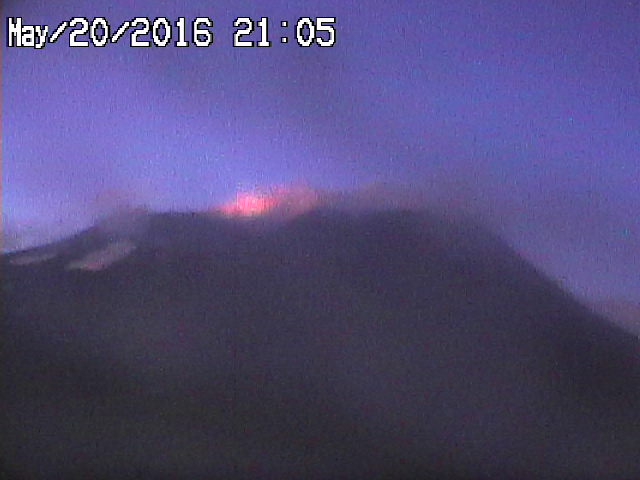
Strombolian activity at Etna's Voragine tonight

Current tremor signal (ESLN station / INGV Catania)

Thermal image (view from Bronte) of the summit lava flow on the western flank (INGV)
After a relatively calm day, Etna seems perhaps about to start another eruptive episode from the Voragine summit crater where strombolian activity has set in a short while ago. Tremor is currently elevated, but with no clear trend so far.
While the lava effusion from the eastern vent at the foot of the NE crater had already stopped yesterday, the lava flow from the summit vent itself, that has been active on Etna's western flank, had remained active during the day.
Second paroxysm from Voragine / summary
Update Thu 19 May 21:22

Glow still visible from the new lava flow on the eastern upper flank of Etna

Current tremor signal (ESLN station / INGV Catania)
The second paroxysm from the Voragine summit crater ended gradually during the course of today. Bad weather prevented detailed observations for most of the time.
At the moment, the lava flow from the new vent at the eastern base of the North-East crater is still visible, but effusion has either stopped or strongly decreased.
ETNA UPDATE, 19 MAY 2016, 11:00 UTC (INGV Catania's official update)
During the afternoon of 18 May 2016, the lava fountaining activity from Etna's Voragine crater passed into a modest Strombolian activity, which continued to feed the lava overflow toward west until the late evening (see first image at left, recorded by the thermal camera at Bronte, EBT).
A second lava flow, which was emitted from an effusive vent located near the lower of the two conelets formed during the subterminal activity of July-August 2014, at the eastern base of the Northeast Crater (NEC), expanded into the northern portion of the Valle del Bove in the direction of Monte Simone.
This lava flow remained active until the early morning hours of today, 19 May 2016 (see second image at left, recorded by the high-definition camera at Monte Cagliato, EMCH), though its most advanced front seemed to be stagnating after midnight. Shortly before midnight, there was a new increase in the volcanic tremor amplitude, and the clinometer installed at Punta Lucia, about 1 km northwest of the NEC, recorded renewed inflation of the summit area of the volcano.
In the morning, the volcanic tremor amplitude showed a sharp increase, and contemporaneously loud and virtually continuous bangs were heard in populated areas to the east and south of the volcano. A dense eruption cloud was blown by the strong wind toward east at an altitude of little more than 1 km above the summit of Etna (see the third image at left, photographed from the village of Tremesteri Etneo, on Etna's south flank).
Ash and lapilli fell onto the east flank of the volcano, in an narrow sector immediately adjacent to the north to area affected by the tephra fall on the previous day. Observation of the activity was difficult due to rather poor weather conditions; instrumental data - mainly the location of the volcanic tremor source and the origin of the infrasonic signals - indicate that a new paroxysmal episode was underway at the VOR.
This was confirmed a few hours later when the images transmitted by the termal monitoring camera EBT (Bronte) revealed a new lava overflow toward west, feeding a lava flow that descended on top of the lava of the previous evening. Eruptive activity was continuing at 09:00 local time, though the volcanic tremor amplitude was diminishing. At the time this update goes online, the inclement weather conditions are preventing observation of the activity going on at Etna's summit.
Second paroxysm at Voragine within less than 24 hours
Update Thu 19 May 07:22
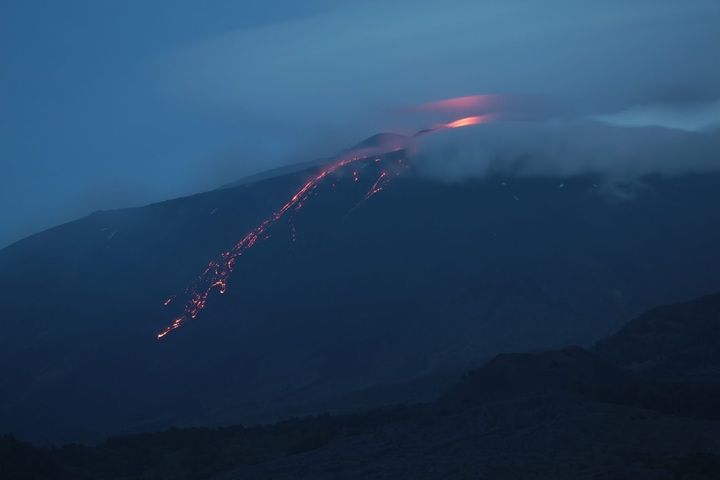
Etna's lava flow from the summit craters descending to the NW (view from Monte Ruvolo / image: Emanuela / VolcanoDiscovery Italia)
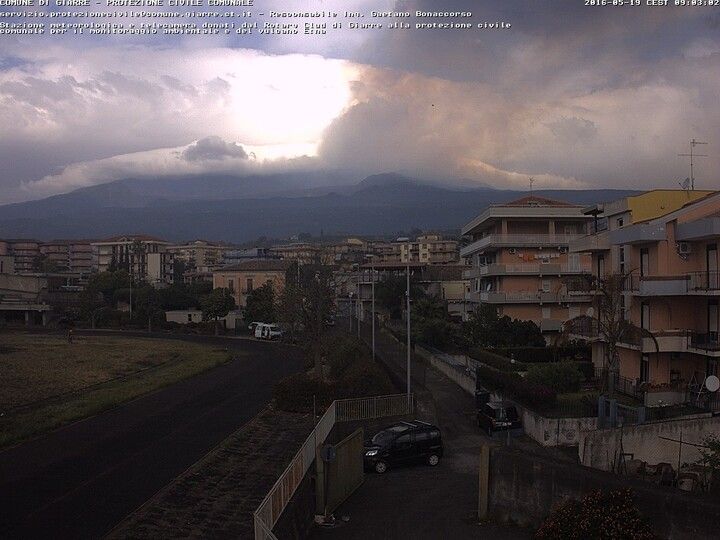
Ash plume from the second paroxysm drifting towards Giarre

Current tremor signal (ESLN station / INGV Catania)
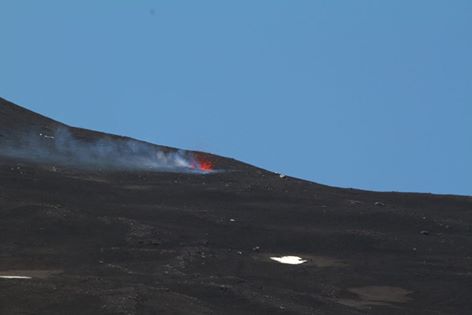
Bocca formatasi alla base Newn vent on the NE base of the NE crater i that yesterday (image: Marco Galasso / facebook)
A second paroxysm occurred at the Voragine summit crater this morning short time ago, i.e. less than 24 hours after yesterday's eruption. The activity is currently still going on but waning. The lava flow on the east side, from the base of the New SE crater, continues to be active, in the meanwhile.
This time, visibility has been even worse and the event could only be inferred from the seismic signal and the ash plume (and ash falls) drifting towards the east (image).
To add to yesterday's update: yet another new vent opened at the base of the North-East crater, at 12:09 local time, with
week spattering and effusive activity:
First paroxysm from summit craters in 2016
Update Wed 18 May 22:28

Lava flow from Etna's New SE crater this evening (Osservatorio Meteorologico Nunziata webcam)
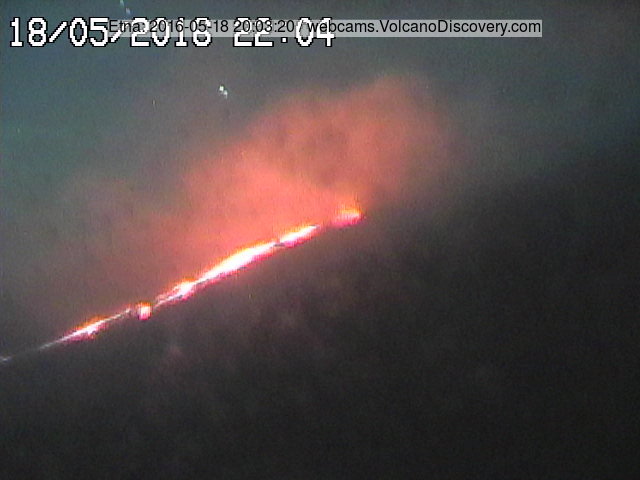
The lava flow seen from the NE

Activity at both Voragina (l) and the flank vent of the New SE crater (r)
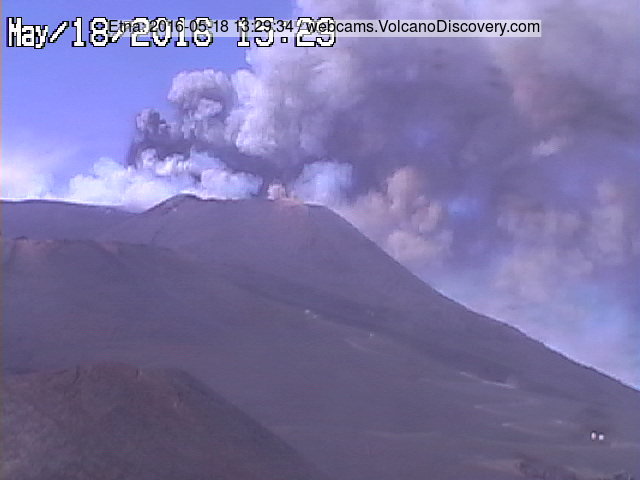
Lava fountaining from Voragine
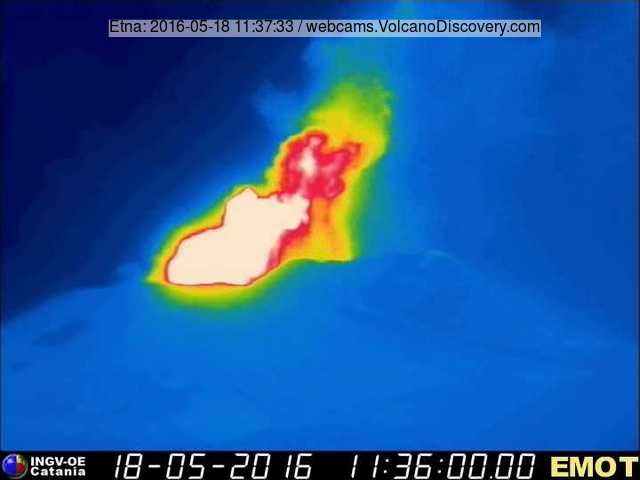
Lava fountaining at Voragine seen through the thermal webcam
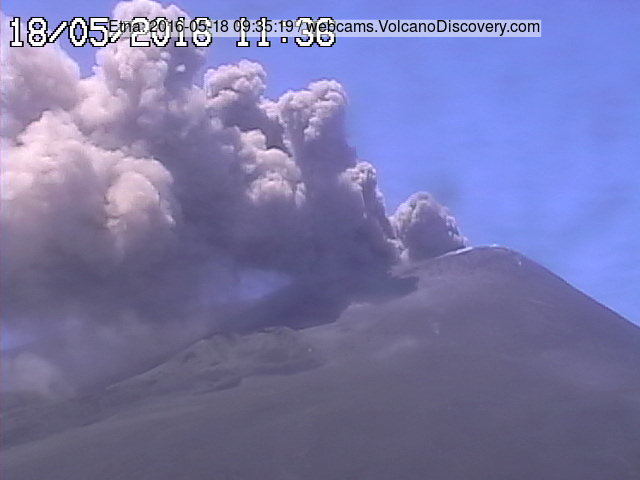
Ash emissions from NE crater this morning

Strombolian activity at NE crater last night
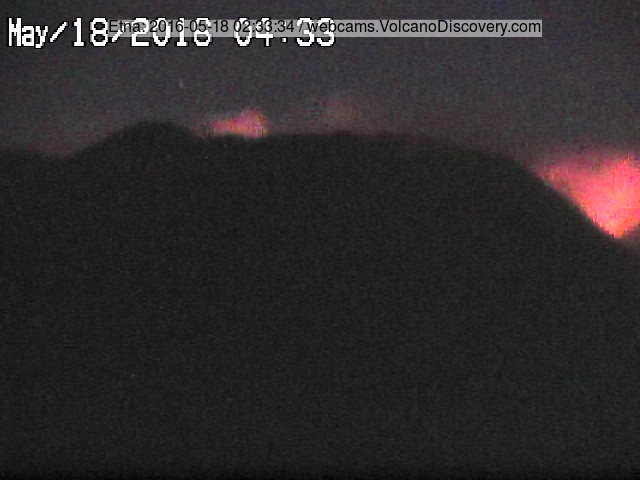
Activity at both NE crater and New SE crater this morning

Current tremor signal (ESLN station / INGV Catania)
The first eruption of Etna in 2016 has been rapidly changing, involving 3 of the 4 summit craters. After yesterday and partly today's strombolian activity from the North-East (and probably New SE) crater, a short, but violent phase of lava fountaining (paroxysm) occurred at the main summit vent, the Voragine. After this, the eruption has become dominantly effusive and is now producing a lava flow from a fissure vent on the lower eastern flank of the New SE crater. The lava flow, with one main channel and few secondary branches, is currently traveling into the Valle del Bove.
The sequence of events at Etna's eruptions is often complex (for a detailed description, see the reports by INGV). Today's eruption was no exception, with some similarities to the
last paroxysm of Voragine on 6 Dec 2015.
The strombolian activity from the NE crater increased during last night and began to produce dense ash plumes during this morning. Early in the morning of 18 May, relatively weak (possibly small strombolian-type) activity began at a vent on the eastern flank of the New SE cone, the same that had appeared on 25 Nov last year.
Around 1 pm, activity rapidly shifted to the Voragine summit crater where strong strombolian activity began and turned into a small paroxysym with pulsating lava fountaining and a lava flow from the summit crater. This activity lasted only a few hours before the current well-alimented lava flow from the New SE crater's flank vent appeared in the afternoon.
from INGV's update 18 May 13:45:
Since the evening of 17 May 2016, there has been an intense Strombolian activity at Etna's Northeast Crater (NEC), with ejection of incandescent bombs above the crater rim and fall of pyroclastics over the flanks of the cone.
This morning, 18 May, this activity was also accompanied by emission of volcanic ash forming a plume that was blown eastward by the wind and rapidly dispersed in the atmosphere.
There were also weak glows at the 25 November 2015 vent on the upper east flank of the New Southeast Crater (NSEC). The volcanic tremor amplitude remained elevated at values similar to those reached on the evening before. On the late forenoon, a clinometer installed at Punta Lucia, at nearly 3000 m elevation and about 1 km northwest of the NEC, recorded rapid inflation (swelling) of the summit area.
Shortly after 12:50 local time on 18 May 2016, the visual and thermal surveillance cameras of the INGV-OE recorded the onset of eruptive activity at the Voragine (VOR), which in just a few minutes evolved into a pulsating lava fountain. At the same time, the Strombolian activity at the NEC diminished and passed into emission of dark ash, and finally ended.
The image at lower left is a frame captured by the thermal monitoring camera at Bronte (EBT), about 45 minutes after the onset of the activity at the VOR. With the beginning of paroxysmal activity, the volcanic tremor amplitude showed a rapid increase, and its source migrated from a position below the NEC toward the VOR. From the Voragine an ash plume rose to 3000-3500 m above the summit and was blown by the wind to east-southeast. During the afternoon lava started to overflow from the western rim of the Voragine-Bocca Nuova depression, feeding a minor lava flow toward west, and limited to the summit area.
At the time this update is being published, lava fountaining is continuing at the VOR. The eruptive activity is monitored continuously by the systems of video and thermal cameras, seismic stations and ground deformation.
from INGV's update 17 May evening:
Since early April 2016, there has been a gradual resumption of summit eruptive activity at Etna, which initially consisted of increased gas emission mainly from the Northeast Crater (NEC) and from the vent that had opened on 25 November 2015 on the upper east flank of the New Southeast Crater (NSEC).
This was accompanied by rather discontinuous and small emissions of ash; during the first half of May, these emissions from the NSEC also produced small anomalies visible in the images of the thermal monitoring camera at Monte Cagliato (EMCT).
On 7 May, an increase in the volcanic tremor amplitude, whose source shifted toward the NSEC, was accompanied by the appearance of a source of infrasonic signals at the NSEC; however, the poor weather conditions allowed only to observe a modest emission of ash from the NSEC (25 November vent) and from the NEC.
During the night of 16 May, very weak and rare glows were observd at the 25 November vent of the NSEC, again accompanied by infrasound signals originating from the same vent. On the early morning of 17 May, the monitoring network of the INGV-Osservatorio Etneo (INGV-OE) recorded a gradual increase of the volcanic tremor amplitude, accompanied by infrasound signals coming from the NEC, and intense degassing with occasional, weak ash emissions from the same crater.
INGV-OE staff present in the area of the Grotta del Gelo (on the upper north-northwestern flank) reported hearing explosion sounds probably coming from the NEC.
Strombolian activity from North-East crater
Update Wed 18 May 05:12
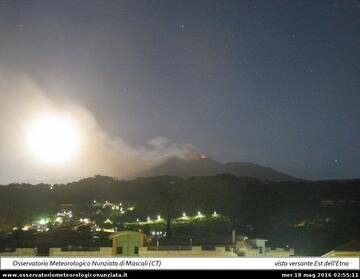
Strombolian activity at the NE Crater (Osservatorio Meteorologico Nunziata webcam)
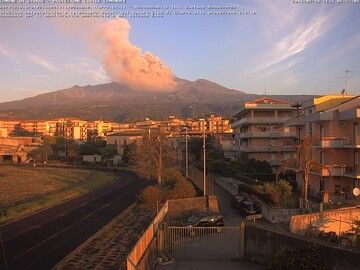
Ash plume this morning (comune Giarre - DPC)

Rising tremor signal (EMFS station, INGV)
Since yesterday, volcanic tremor has been gradually increasing and during the evening mild explosive strombolian activity started from the North-East crater.
At the time of updating, this explosive activity associated with ash emissions has started to produce a dense plume
Intermittent, weak ash emissions from NE crater
Update Sun 03 Apr 08:20
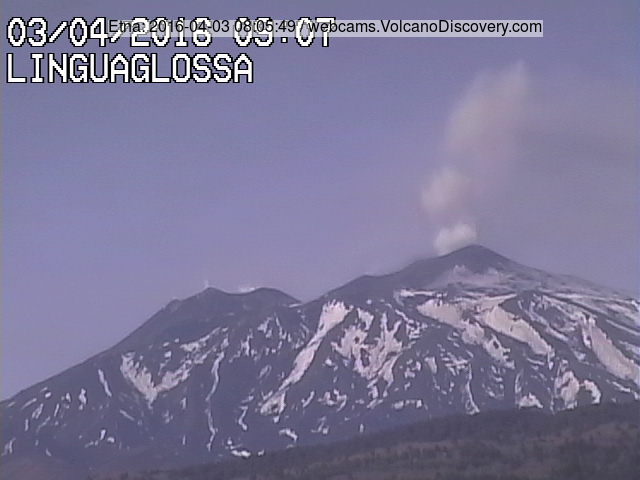
Steam plume mixed with light ash from Etna's NE crater
Activity remains low at the volcano. Only weak, intermittent ash emissions with decreasing tendency continue to occur from the NE crater. However, they carry no signs that could indicate fresh lava, and likely consist of older fragmented rock material only.
Surface temperatures and seismic activity are low.
Ash emissions from NE crater
Update Thu 31 Mar 07:50

Ash emissions from Etna's NE crater this morning
Intermittent weak to moderate ash emissions (presumably from older pulverized rock) have been occurring from the North-East crater, where also weak incandescence can be seen at night.
Apart from this and an incandescent fumarole on the New SE crater, no other significant activity is currently occurring at the volcano. Tremor levels have been low.
New deformation data show inflation changed to deflation
Update Mon 14 Mar 17:46
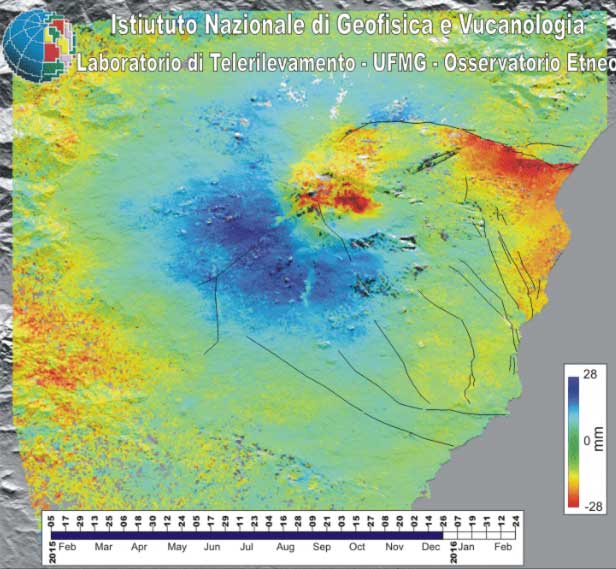
Deformation at Etna in late Dec 2015 (INGV)
INGV Catania published the result of very high-resolution satellite-based measurements of ground deformation of Etna during the period between Feb 2015-Feb 2016.
They show that Etna's dominant trend of deformation has changed from inflation (in blue) to deflation since the latest eruption in early December.
[
Link to animated graphic ]
Inflation of the entire volcanic edifice continued until November 2015, before the violent paroxysmal episodes occurred in December. During this event, the deflation that accompanied the eruptive activity has almost completely neutralized the preceding inflation, which likely means that most of the accumulated magma inside the volcano had been erupted during the recent activity.
This also suggests that Etna, currently very calm, might not be in for significant eruptions in the near future of the coming months (although only she herself knows for sure...)
The data were obtained using a modern interferometric techniques from TOPSAR (Terrain Observation with Progressive Scans SAR) radar images acquired by the Sentinel-1A satellite and have a precision in the sub-centimeter range.
Other interesting observations include eastward sliding movements of the northeastern and eastern flanks of Etna during and after the latest eruptive phase.
Source: Mt. Etna - Monitoraggio delle deformazioni del suolo con Sentinel 1 A. (INGV Catania)
Explosion and ash emission from North-East crater
Update Wed 24 Feb 10:16
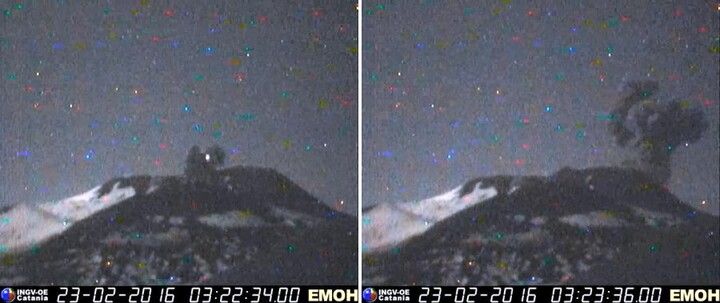
Eruption of Etna's NE crater yesterday morning (INGV Catania)
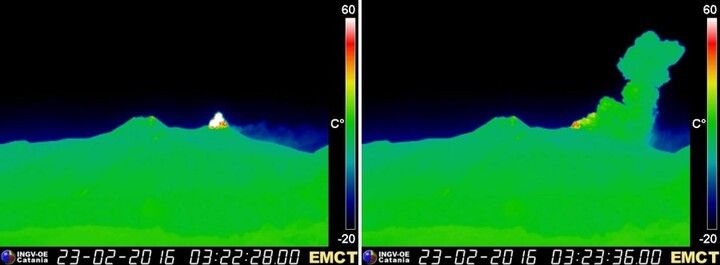
Thermal image of the eruption showing incandescent material ejected from NE crater
An unusual eruptive episode occurred yesterday morning from the volcano's NE crater (the least active of the summit vents over the past few decades). Incandescent bombs were ejected above the rim of the crater and an ash plume rose several hundred meters.
Whether this is the beginning of a more significant eruptive phase, after a period of relative calm since the violent paroxysms of Voragine summit crater in early Dec 2015 remains to be seen.
INGV published the
following report:
"During the month of January 2016, Etna's eruptive activity has maintained rather low levels. Early that month, a few weak ash emissions occurred from the 25 November 2015 vent located high on the eastern flank of the New Southeast Crater (NSEC) cone; similar phenomena were repeated during the last week of January and once more on the morning of 6 February. During the same time interval, degassing from the Northeast Crater (NEC) were sometimes accompanied by the emission of minor traces of ash.
A field survey was carried out in Etna's summit area by INGV-Osservatorio Etneo (INGV-OE) staff on 19 February. During the visit, no ash emissions occurred from the summit craters, but the NEC was the site of intense degassing from its open conduit; due to strong wind it was not possible to hear if there was any acoustic activity coming from the crater, which typically produces loud bangs and rumblings. At the other summit craters, degassing was limited to extensive fumarolic areas along the crater rims. The eruptive products of December 2015, which fill the single huge depression constituted by the Voragine and Bocca Nuova, were covered with snow except in the areas where vapors were emitted from fissures formed by compaction of the deposit.
At 03:22 UTC (=local time -1) on 23 February 2016, the video and thermal cameras of the INGV-OE recorded an explosive event at the NEC, which ejected incandescent pyroclastics to several tens of meters above the crater rim (see image at top left, recorded by the high-definition visual camera at Monte Cagliato, on the east flank of Etna - click on image for larger version) and produced a dark ash plume that was blown northeastward by strong wind. The images at center left (click on image for larger version) were recorded by the high-sensitivity camera on the Montagnola (EMOH, on the upper south flank of Etna) and also show a few lightning flashes in the ash cloud.
The images recorded by the thermal surveillance camera at Monte Cagliato (EMCT, see images at bottom left - click on image for larger version) show a conspicuous anomaly generated by the explosion, which was followed by minor ash emissions that gradually diminished; as of the late morning of 23 February, intermittent and weak ash emissions are continuing from the NEC.
" (INGV Catania)
New ash emissions from NE crater
Update Sat 12 Dec 16:19
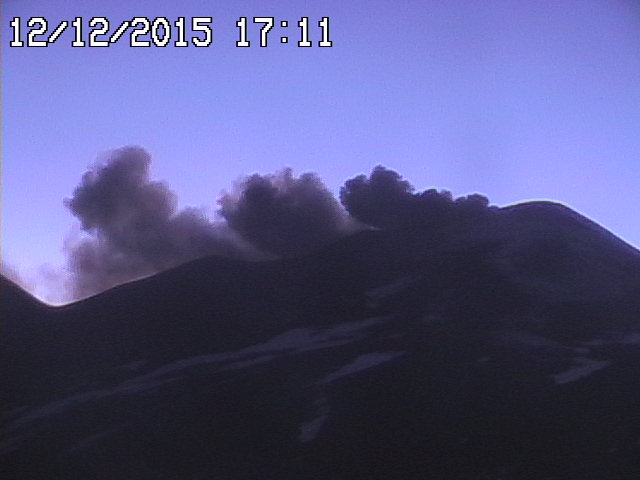
Ash emissions from Etna's NE crater
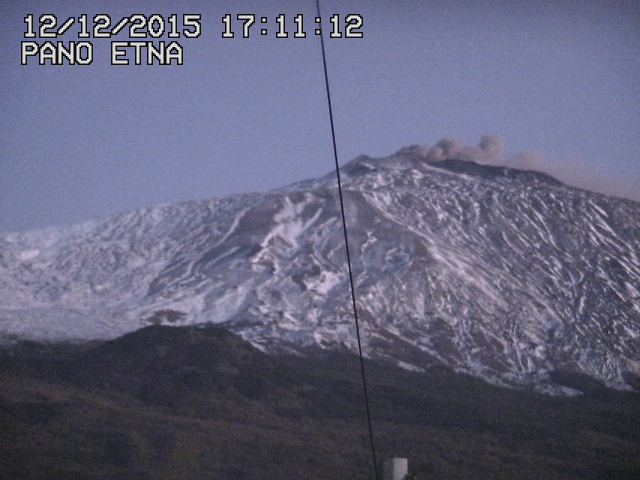
Etna seen from the north with ash emission from NE crater
The NE crater started again to produce puffs of ash, generating small plumes drifting southwest.
Activity ceased
Update Fri 11 Dec 08:49

Etna this morning

Current tremor signal (ESLN station / INGV Catania)
The volcano is at the moment calm. During Wednesday, the initially strong ash-venting activity from the NE crater decreased and stopped yesterday.
Earthquake activity at the NE side also progressively decreased.
Decreasing activity
Update Wed 09 Dec 13:45

Ash emissions from NE crater
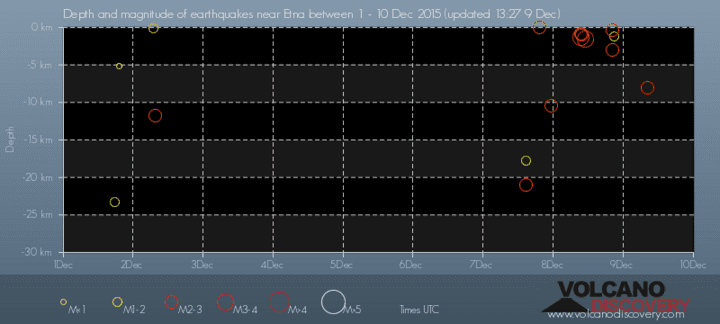
Depth vs time of recent earthquakes under Etna
Ash emissions from NE crater continue, but seem to be decreasing in intensity.
According to INGV scientists, the volcano had experienced mild inflation prior to the paroxysm last weekend, and this inflation disappeared. The earthquake swarm on the NE side, still ongoing, but also weakening, is thought to be the cause of compression stress, not extension. In that case, the scenario of a new flank eruption on the NE rift in a near future is much less likely.
Strong ash emissions from NE crater
Update Wed 09 Dec 08:04
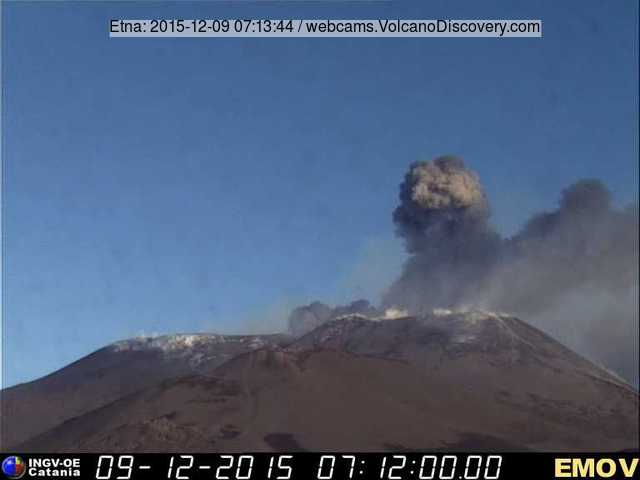
Ash emission from Etna's NE crater this morning
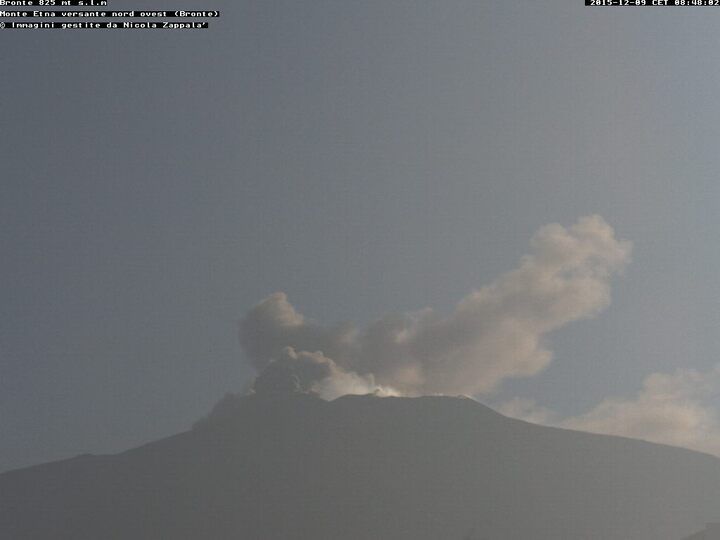
Ash plume from NE crater seen from west
Another of the summit vents seems to be becoming protagonist in the current eruptive phase: the NE crater has been producing near-continous small to moderate ash emissions throughout the night and the morning. Incandescence was occasionally seen at the base of the plumes as well, suggesting strombolian activity.
The other vents, in particular Voragine and New SE crater, have been calm.
The NE crater, formed in 1911, had not had much significant activity since 1995-1996 when it produced a series of spectacular paroxysms with associated lava flows.
Shallow earthquakes under Pernicana fault could herald new flank eruption?
Update Tue 08 Dec 19:35
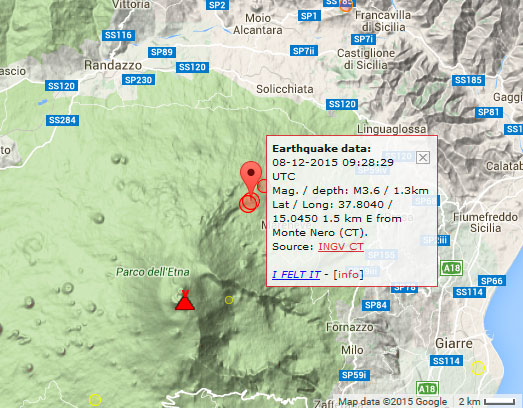
This morning's earthquakes at the Pernicana fault of Etna

Explosion from NE crater

Etna's lava flow last night (photo: Alessandro Lo Piccolo / facebook)

Current tremor signal (ESLN station / INGV Catania)
Over the morning, surface activity at Etna's New Southeast Crater strongly decreased, and the lava flow seems no longer be active now. Tremor has dropped as well, but ash emissions and occasional explosions continue from several of the summit craters, including the Northeast.
Another significant sign of unrest appeared this morning in the form of small earthquakes, up to magnitude 3.8 and some felt by locals, at shallow depths on the Pernicana fault in the NE sector of the volcano.
The most significant quakes (out of 46 total recorded until 12:45 local time) were at 10:28 (M3.8), at 10:32 (M2.9), at 10:36 (M2.4) and 11:53 (M3.2) at depths between 2-4 km.
Small fractures approximately 2-4 cm wide were noticed on the road surface of the Mareneve road, above an altitude of 1450 m above sea level.
In addition, at the same time, two earthquakes were recorded under the loweer northern slope in the Solicchiata area at 00:21 (M2.6) and at 10:36 local time (M2.4) at depths of between 7 and 14 km.
The Pernicana fault has in the past often acted as the "opener" of the NE rift zone, prone to flank eruptions (last so in Oct 2002). Could this time be similar, could the earthquakes be a precursor of another flank eruption ? Nobody can be sure, but for sure, these signs are at least a bit worrying.
New lava flow into Valle del Bove
Update Tue 08 Dec 09:09

Lava flow from Etna's New SE crater this morning
Lava fountaining from the pit crater on the upper New SE cone's flank continued all day yesterday and fed a lava flow with two branches, the main one headed to the east reaching quickly the Valle del Bove, a lesser one to the NE base of the cone.
Activity today has decreased, but lava effusion seems to continue. This is likely only a pause in what is certainly one of Etna's most interesting eruptive phases in recent years.
Notice: We offer a volcano special tour to Etna from 11-14 Dec!Lava flow from New SE crater
Update Sun 06 Dec 15:12

Lava fountaining and lava flow from NSEC (Photo: Emanuela / VolcanoDiscovery Italia)

Small pyroclastic flow detaching from the lava flow (Photo: Emanuela / VolcanoDiscovery Italia)
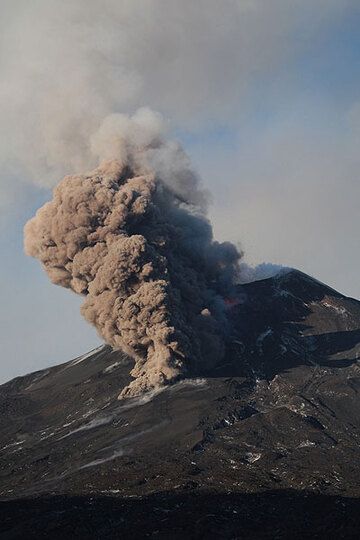
Small pyroclastic flow detaching from the lava flow (Photo: Emanuela / VolcanoDiscovery Italia)
The activity at the New SE crater has been continuous all day and is still gradually increasing. A low lava fountain feeds a lava flow from the new pit crater. This flow occasionally generates small pyroclastic flows as parts of its front collapse on the steep slope.
Some pictures taken around noon:
Strombolian activity from New SE crater
Update Sun 06 Dec 09:24
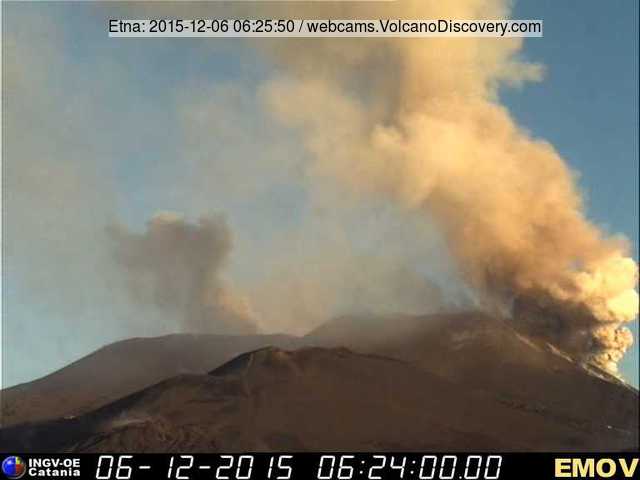
Ash plume from Etna's New SE crater (r)
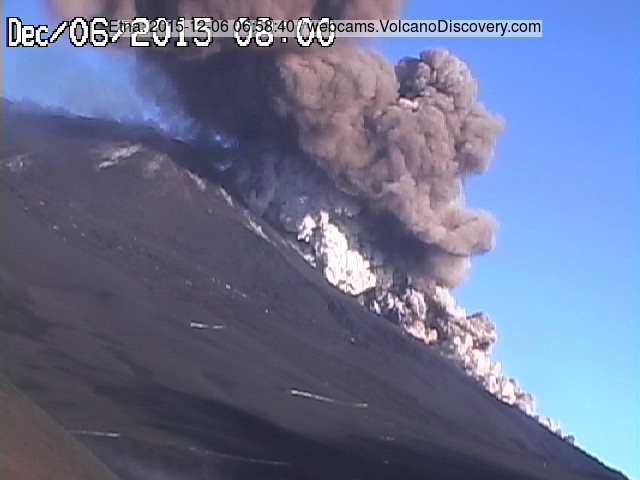
Activity from New SE crater
Activity at the volcano remains elevated, but a significant change is occurring:
While explosions continued from Voragine crater and tremor levels remain high, it seems that since a few hours ago, most magma has now been using another vent: the new pit crater on the upper flank of the New SE crater.
It already has had intermittent activity throughout the current eruption, but this morning started to produce intense strombolian activity and dense ash plumes.
The situation remains highly interesting.
First visit to our site? If you havn't done it yet,
download the Volcanoes & Earthquakes app to get one of the fastest volcano news online:
Android |
IOS



































































